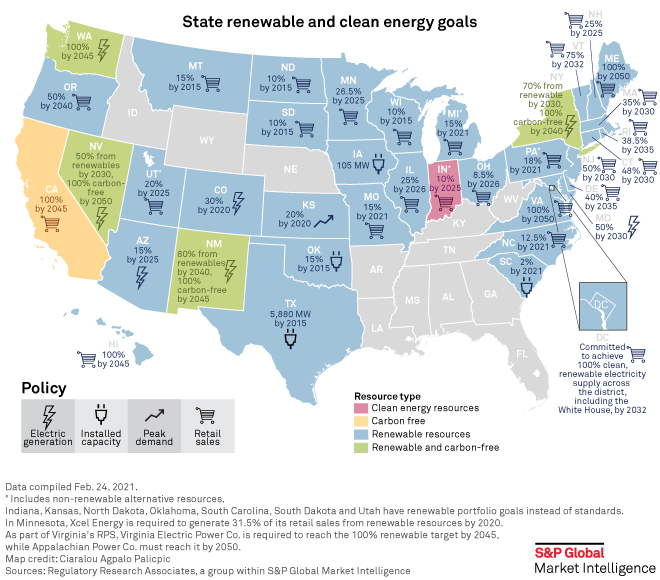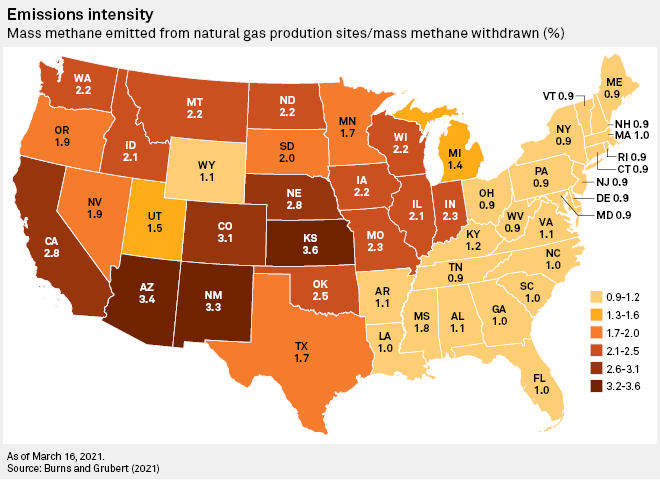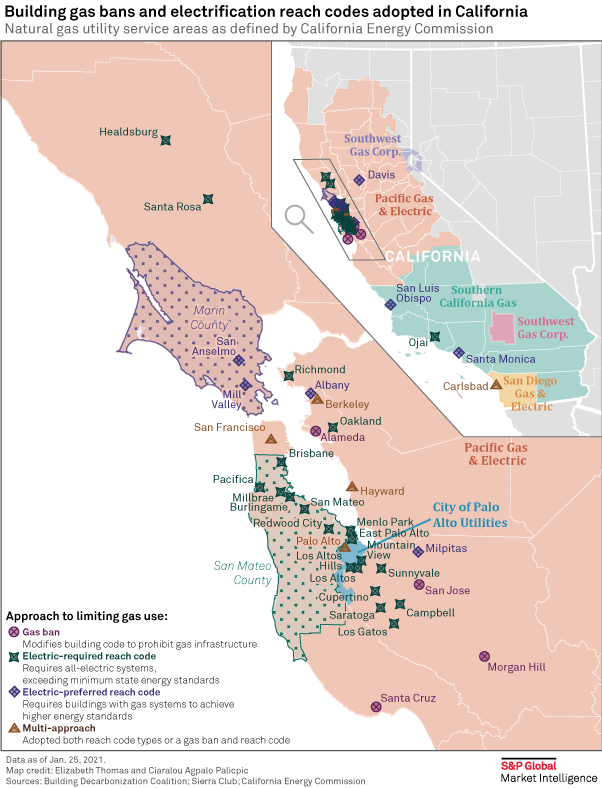S&P Global Offerings
Featured Topics
Featured Products
Events
S&P Global Offerings
Featured Topics
Featured Products
Events
S&P Global Offerings
Featured Topics
Featured Products
Events
Featured Products
Ratings & Benchmarks
By Topic
Market Insights
About S&P Global
Corporate Responsibility
Culture & Engagement
Investor Relations
Featured Products
Ratings & Benchmarks
By Topic
Market Insights
About S&P Global
Corporate Responsibility
Culture & Engagement
Investor Relations
S&P Global Offerings
Featured Topics
Featured Products
Events
Language

The future for cities will be sustainable—but how soon those in the United States will go green is still up in the air. Municipalities are leaning into sustainable finance to fund projects that benefit the environmental and provide societal solutions. Some U.S. cities have prioritized electrifying their buildings to begin advancing their energy transitions, but pushback over bans on the use of natural gas in utilities remain a challenge to these decarbonization efforts.


S&P Global Ratings expects U.S. municipal green-labeled debt to continue grabbing a larger share of the municipal market in 2021, estimating green-labeled issuance of about $18 billion, or 4.1% of total municipal issuance, as projected by S&P Global Ratings Research.
For the total sustainable debt market, we believe it is possible that issuance could surpass $30 billion for 2021, bringing cumulative issuances to more than $100 billion since the first municipal green bond was issued by the Commonwealth of Massachusetts in 2013. The extraordinary pace of growth in social and sustainability bonds, combined with the role of the pandemic in driving social bonds forward in 2020, adds complexity to the forecast.

Proposals to form a national clean electricity standard have become a central focus of climate change legislation in the new Congress as U.S. President Joe Biden pushes for a carbon-free power sector.
The concept has support from Democrats and Republicans, with nearly 40 U.S. states already adopting renewable or clean energy goals or standards, according to S&P Global Market Intelligence data. But lawmakers backing a clean electricity standard, or CES, still need to resolve differences over when the U.S. power sector would need to decarbonize, among other issues. 

As U.S. states look to decarbonize, where they get their natural gas may be an important part of their emissions profiles, according to a recent study.
Calculating the upstream greenhouse gas intensity of each state's gas supplies, researchers at Georgia Tech's School of Civil and Environmental Engineering found that gas consumed in 2018 in the Lower 48 had methane emissions profiles that ranged from 0.9% to 3.6% of the total gas withdrawn that supplied states' consumption. 
Oil Giant Saudi Arabia Aims to Build The Zero-Carbon City of the Future
In an isolated patch on the Red Sea coast, Saudi Arabia has unveiled a grand vision of a futuristic zero-carbon community called Neom, fueled by hydrogen, a showpiece for Crown Prince Mohammed bin Salman in his efforts to diversify the economy of the world's top oil exporter.
Read the Full ArticleMassachusetts Governor Signs Climate Change Legislation Calling for Net-Zero Emissions
Massachusetts is the latest state to sign a net-zero emissions into law after Governor Charlie Baker signed a comprehensive climate change legislation March 26, calling for the state to achieve net-zero by 2050.
Read the Full Article
With Democrats in control of the White House and Congress, Edison Electric Institute, the trade group representing investor-owned electric utilities, plans to advocate for policies that support the industry's transition to cleaner energy and recognize the vital importance of infrastructure investment.
"As always, our North Star is serving our customers and we will continue to center our efforts on three main pillars: maintaining the steady and strong transition to clean energy; modernizing the energy grid to make it more dynamic, more resilient and more secure; and developing the innovative solutions our customers expect and deserve," EEI President Thomas Kuhn said during a Feb. 10 virtual presentation.
Kuhn and other EEI leaders noted that the electric industry is "the most capital-intensive industry in America," racking up nearly $140 billion in capital expenses in 2020. Nearly 50% of these investments were focused on transmission and distribution.
"The transmission system is key to integrating more renewables and more clean energy into the energy grid affordably and reliably," Kuhn added in the annual Wall Street briefing.
EEI leaders largely applauded the Biden administration's climate and energy policy goals, which include a $2 trillion clean energy and green infrastructure plan.
"To achieve our clean energy goals in the fastest and most cost-efficient manner while also protecting and helping to facilitate the development of this critical infrastructure, there are critical areas that the administration can focus on to make progress," said Philip Moeller, executive vice president of the business operations group and regulatory affairs at EEI. "First, we need to take a more holistic view of transmission system needs and we need to work to improve policies and processes to evaluate and promote the development of cost-effective interregional, multiregional or cross-connection transmission facilities."
San Jose, Calif., adopts citywide building gas ban
San Jose, Calif., will ban natural gas use in most new construction, becoming the largest U.S. municipality to adopt a citywide building electrification requirement to combat climate change.
Read the Full ArticleNew York to Weigh All-Electric Buildings Mandate in Climate Law Implementation
An advisory panel responsible for developing policies and proposals to cut building greenhouse gas emissions presented a preliminary set of draft proposals Feb. 4. They included developing an all-electric construction code and prohibiting New Yorkers from replacing appliances and building systems with fossil fuel equipment.
Read the Full ArticleDenver Sets Targets for All-Electric Construction in New Homes and Buildings
Denver will take steps to ensure new homes and buildings are all-electric in the coming years, marking the Mile High City's planned transition away from natural gas heating. City and county climate officials announced the policy in a blueprint for achieving net-zero energy status in Denver's new building stock, relased on Jan. 26.
Read the Full Article
The council responsible for developing model building codes overhauled its process for setting minimum energy efficiency requirements, blocking a pathway that local governments have used to secure decarbonization measures like building electrification and electric vehicle charging.
The move drew swift criticism from environmentalists, some local governments and Democratic leaders, who called the move a sign of the influence of building developers and the gas industry within the council, the International Code Council Inc., or ICC. Groups like the National Association of Home Builders and Leading Builders of America viewed the overhaul as a means of preventing climate-focused groups and civil servants from compromising the council's mission of fostering safe, affordable building development. 
State Laws Halting Municipal Gas Bans Unlikely to Stem Power Burn Declines in 2021
As state governments across the US continue to ban local restrictions on natural gas usage, higher prices and growing renewable power supply are still likely to weaken demand for the fuel this year.
Read the Full ArticleStates Launch Anti-Ban Blitz as Electrification Efforts Grow
Heading into 2021, the movement to restrict gas use in new construction in Washington and Massachusetts towns and cities continued to evolve, while state lawmakers sought to prohibit local governments from pursuing the policy.
Read the Full ArticleMomentum Gathers to Prohibit All-Electric Building Requirements
Utah, Arkansas and Mississippi joined four other states in prohibiting local governments from restricting natural gas use in buildings as similar bills advanced in at least 14 more states and stalled in Colorado.
Read the Full Article
In 2019, the global value of real estate was estimated to be US$217 trillion – roughly 2.7 times the GDP of the entire world. Global real estate consumes approximately 40% of world energy annually and accounts for more than 20% of greenhouse gas (GHG) emissions. This highlights the contribution the real estate industry can make to help achieve the Paris Agreement goal of limiting global warming to well below 2°C from pre-industrial levels.
Remote Working is Testing U.S. Office Landlords' Credit Quality
The COVID-19 pandemic has accelerated the adoption of remote working and S&P Global Ratings thinks tenants downsizing their footprint is a growing risk, pressuring demand for office real estate.
Read the Full Report

